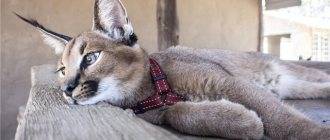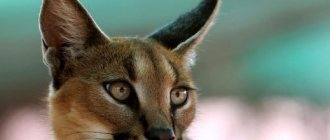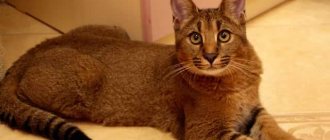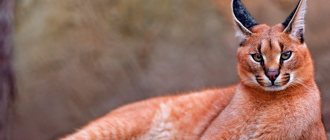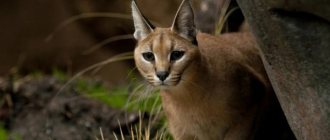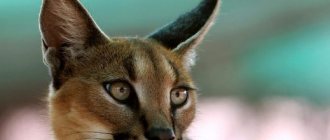History of the breed
The desert lynx is easy to tame. Thus, the ancient Turks and Kazakhs from the poor classes took a tamed caracal with them to hunt, using it to catch hares, antelopes, and birds. Over time, the fashion for such hunting fell away. Thus, the need to tame the desert lynx also disappeared.
Until the 80s of the last century, representatives of the Caracal cat breed were found only in the wild and zoos. At the Moscow Zoo, an ordinary cat once wandered into the enclosure of a desert lynx, and then gave birth to a kitten of an unusually beautiful color. In addition, small tassels hung from the ears of the newborn purr.
The news of an accidental interspecific crossing, which was crowned with success, quickly spread throughout felinological circles. Breeders began to breed another breed of cats.
Meanwhile, over time, the popularity of Caracal cats - beautiful animals that are not difficult to tame - has sharply increased among exotic lovers.
A cross between caracals and domestic cats has been officially registered as the caraquet breed.
Number of species
In some areas of Africa, there are many caracals, so they are considered a common animal there. A wild cat can cause harm to farms and farms, so it is hunted as a pest. Such deliberate extermination of representatives of the species caused a decline in numbers.
one of the caracal subspecies may become extinct
There are very few caracals left in Central Asia. One of the subspecies (Caracal caracal michaelis) living in Turkmenistan is considered endangered. There are no more than 300 individuals of this subspecies left. The subspecies is listed in Appendix II of CITES (the list of animal species covered by the Convention on International Trade in Endangered Species of Wild Fauna).
The caracal is a species of mammalian predator of the cat family. They are called wild steppe cats and desert lynxes. They inhabit savannas and steppes, lead a solitary lifestyle and hunt small animals. Caracals are similar to cheetahs and lynxes. They also deftly climb trees and jump far. However, they themselves can become victims of predators. Caracals can be tamed. To do this, you need to equip an enclosure. In captivity, wild cats must be fed meat. In order for the desert lynx to live long and be healthy, it needs good care and the participation of a veterinarian.
Description of caracal
From the description of the breed it is clear that the desert cat Caracal is similar to a lynx in some features: ears with tassels, round pupils, large limbs, and a muscular body.
Otherwise, she looks like an exceptional individual:
- Folding graceful body measuring 65–85 cm in length. Height at withers 40–45 cm.
- A long tail.
- Small head.
- Elongated muzzle. There are black eyeliners around the eyes and also on the cheeks.
- Large dark nose with a pink mark in the middle.
- Protruding black ears 4–5 cm high with black crescent-shaped tassels. The inside of the ears is “trimmed” with white edging.
- Long massive limbs.
- Short six medium firmness.
The desert lynx has a monochromatic sand color with a red or brownish tint. The belly, neck and chin are painted white.
The weight of an adult animal can vary between 12–18 kg.
Lifestyle of caracals
Predators prefer a nocturnal lifestyle to a daytime one. Their life is spent in rock crevices, burrows of foxes and porcupines, where they hide during the day. The same shelter can be occupied by a cat for several years in a row. Large territories belong to males, females have enough of the periphery.
Water is not a hindrance for them; the steppe lynx can easily swim across a small lake. You can’t hide from the beast even in a tree—it’s also a convenient place for caracals .
In spring and winter, wild cats can be seen during the daytime.
A cat hunts not by running after its prey, but by sneaking up on it and overtaking the prey with long jumps. The caracal jumps up to 4.5 m in length and 3 m in height. The retractable claws are so sharp and the animal's speed is high that sometimes the hunter simultaneously grabs several birds in a flock.
The cat does not leave its prey on the ground, but drags it to the nearest tree, so that in case of danger it does not risk the captured food.
Character and education
When purchasing a caracal desert lynx for themselves, cat lovers should remember that a predator always remains, first and foremost, a predator.
When raising such a pet, you need to be extremely consistent, specifically put forward your conditions, slowly accustoming the new “family member” to subordination, as well as appropriate behavior in your home.
The desert lynx is distinguished by the following character traits.
- Phlegmatic calm.
- Good nature.
- Passion for various games.
- Owner's instinct. If a tamed desert lynx always tries to get along with other pets living together, cats, dogs, parrots, then it will drive away other people's animals that accidentally enter their territory.
- Curiosity. The cat will be the first to run to the threshold, barely hearing footsteps outside the door. She will also immediately rush to the bushes as soon as they move.
What does it eat?
As mentioned above, the caracal is not too picky about food. He is ready to eat almost any prey that he can catch and kill
Therefore, quite often its diet consists of various rodents - gophers, jerboas and gerbils. In some cases, tolai hares may become victims. And if you’re lucky, the caracal can easily cope with small antelopes or goitered gazelles that have strayed from the herd.
However, the diet often includes more exotic prey. For example, caracals do not disdain hedgehogs and reptiles. If there is no prey for a long time, they may well feast on insects. In regions where such prey lives, it may attack a mongoose or a young ostrich.
But caracals do not feed on carrion - the too pungent smell emanating from rotten meat permeates the dense skin of the predator and may well play a bad joke during an ambush hunt. Although, if fresh remains from the recent food of another predator come across, the caracal will not demonstrate excessive disgust.
Care and maintenance at home
If a wild caracal cat is placed in a domestic environment, it will require appropriate care.
The desert lynx should be brushed no more than once every 6–7 days.
You should only bathe your cat if its fur is very dirty. These pets love water treatments - they will happily splash around in the bathtub with rubber ducks.
The cat's claws on the front paws are “cut” with a laser in veterinary clinics or nurseries. The pet’s claws on the hind legs will have to be sharpened yourself.
In addition, you will need to clean your four-legged pet's eyes and ears once a week.
Such purrs are pets of a relatively symbolic species. The caracal belongs to the category of tamed pets. These domesticated predators simply need fresh air, so they should be walked as often as possible, kept on a leash.
Caracal cats are best owned by owners who have their own private home, so that the desert lynx can be given free range in the yard.
What to feed a caracal
The diet of a domestic caracal should include:
- meat (beef, rabbit);
- poultry (quail, chickens);
- feed rats and mice;
- eggs.
It is advisable for the cat to eat live food.
In rare cases, it is permissible to feed commercial premium food specially designed for Maine Coons.
Domesticated desert lynxes should always have free access to water. These pets should be fed twice a day. Give your cat a fasting day every 1.5–2 weeks, give them only water.
Diseases of the steppe lynx and their prevention
The care and health of a domestic caracal are interconnected things.
These animals are naturally endowed with strong immunity. However, they will need to be taken to the doctor regularly for checkups and vaccinations.
Caracal cats should not be fed pork to avoid the development of pseudorabies.
Lifestyle of the steppe lynx
The life of a wild caracal kitten begins after 75–80 days of the female's pregnancy. As a rule, there are no more than three cubs in a litter. The litter is born blind, and only two weeks later the kittens begin to see. Until this moment, the female jealously guards the offspring, hidden in a gorge or an abandoned hollow of a fallen tree.
Female steppe lynx are caring and zealous mothers
The color of caracal cubs differs from the appearance of adult individuals due to the large number of dark specks on their fur. Over time, only the muzzle remains spotted.
A month after birth, the kittens begin to develop the territory near the den, and after another month the female transfers the babies to solid food.
Regarding the latter, it is worth noting the following:
- Caracals feed mainly on small rodents and birds like guinea fowl;
- Steppe lynxes forage for food at night;
- These animals hunt, reaching prey with the help of large jumps (up to 5 meters in length) or waiting at watering holes;
- These cats make caches of food high in the trees.
Since the animal is accustomed to life in arid areas, the caracal can go without drinking for a long time - for up to ten days, this cat is able to obtain liquid only from food. In this case, the diet of the desert lynx is expanded by including grass and berries (for example, grapes) in the menu.
Caracals are dexterous and intelligent predators, skillfully camouflaging themselves among thickets of bushes. So these animals have few enemies. The main threat comes from birds of prey during the period of raising their offspring. And for adult individuals, lions and hyenas become enemies if the animal lives in African savannas, or steppe wolves and alabai guarding sheep (when it comes to Kazakh or Turkmen steppe lynxes).
Hunting for caracal is prohibited in the countries of the former USSR, since the species is on the verge of extinction. At the same time, these animals do not take root in zoos. Therefore, nature reserves and sanctuaries are organized in the habitats of desert lynxes.
However, local residents often engage in poaching of steppe lynx due to the threat of a reduction in livestock numbers.
Video: caracal hunting
Reproduction and care of offspring
Caracals “walk” all year round. The female desert lynx usually has several partners at the same time. She raises the cubs herself. During fruiting, which lasts up to 3 months, she arranges several reliable shelters in hidden places.
Usually such cats give birth to 2-3 caracal kittens. To protect their offspring from other predators, the desert lynx carries its kittens from shelter to shelter every day.
In the first month, kittens eat only mother's milk. Then the cat gradually accustoms them to solid food, teaches them the intricacies of hunting, and then says goodbye to them as soon as the offspring have reached six months of age. Young caracals, “set free”, settle near their mother’s den.
Wild lynxes live 11–14 years.
Habitat
Now let's talk briefly about the habitat of the caracal.
They can be seen in savannas, steppes, deserts and even foothills. Distributed in Africa, Central and Asia Minor, the Middle East and the Arabian Peninsula. But in the CIS it is almost never found. Quite rarely it lives in the deserts located in the south of Turkmenistan. From here it sometimes reaches the Mangyshlak Peninsula, passing along the shores of the Caspian Sea. In addition, there were reports of a meeting with him in Uzbekistan (near Bukhara) and Kyrgyzstan.
The caracal also lives in Russia - on the territory of Dagestan. True, their number is small; according to experts, no more than one hundred individuals.
In general, there are about ten species and subspecies of caracals - they differ relatively little from each other and, as a rule, inhabit specific regions, rarely intersecting with each other.
How much does a kitten cost and how to choose
Felinologists do not advise buying a desert lynx kitten from breeders with an unverified reputation, even if the caracal is sold at a price that is tempting for cat lovers.
It is not uncommon for sick or wild pets to be sold without the proper package of documents. It is better to give preference to certified nurseries. A lynx kitten is expensive - after all, it is an exotic pet.
Caracals cost about 430–480 thousand rubles in Russia. You can buy these expensive cats, for example, in Moscow. There are 4 nurseries in the capital.
There is one nursery in Kyiv. There, domesticated steppe lynx can be purchased for approximately 200–220 thousand hryvnia.
Origin
In ancient times, some wild cats were domesticated by people. The main purpose of domestication is hunting game. The steppe lynx was one of the first cat breeds that was decided to be domesticated and taught to live among people. The animal is distinguished by high intelligence, flexible mind, but besides this, it is obedient, devoted and loves its owner very much. Richer owners preferred to acquire cheetahs, which are more expensive. A baby caracal cost relatively little money, so people who were not so wealthy chose them as companions.
Trophies of an adult animal:
- hares;
- small ungulates;
- feathered.
Now the wild desert cat often lives in private homes with wealthy owners. This breed is expensive, and a lot of money goes into its maintenance. However, the owners note that the pet, raised from an early age, has a balanced, soft, playful character. The cat is graceful and very beautiful. The breed is especially popular among Arabs and Indians. Noble nobles buy exotic caracals, which always accompany their owners.
The right diet
A very important aspect in keeping an unusual pet is the caracal’s nutrition. Fortunately, you won’t need too complex or exotic products here.
The domesticated caracal happily eats almost any meat product. For example, he does not refuse rabbits, gophers and other rodents. He enjoys eating beef and chicken, including boiled chicken. It would be a good idea to include fish in your diet - sea fish can be given raw, but freshwater fish must be cooked to ensure that the eggs of parasites are destroyed.
Also, do not forget to give your pet minerals and vitamins. You can dissolve them in water or simply mix them with meat.
But it is not advisable to feed a caracal pork. Fatty meat can lead to serious obesity - the animal moves little and may develop health problems over time.

